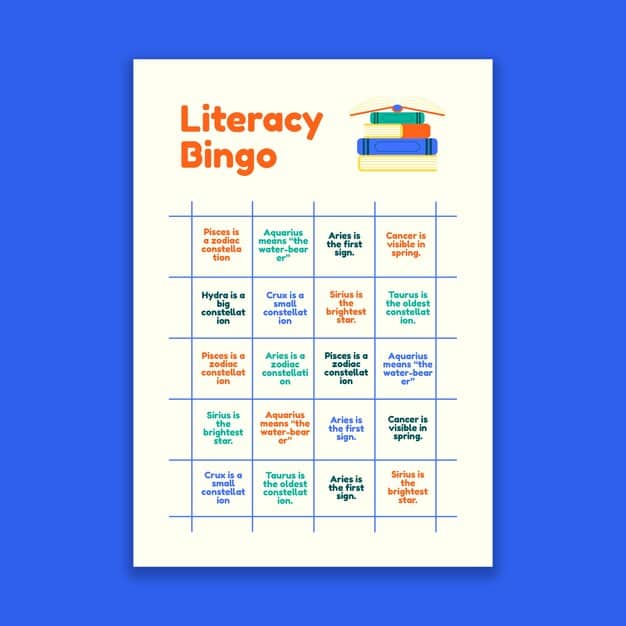Revitalize Your Book Club: New Reading Approaches for 2025

To revitalize a book club stuck in a rut, implement fresh strategies for selecting engaging reads, such as thematic months, genre challenges, or author spotlights, ensuring diverse literary experiences and sustained member interest for 2025.
Is your book club experiencing a creative drought, where every meeting feels like a rerun and selecting the next read has become more of a chore than an exciting discovery? If your discussions lack their usual spark and members seem less engaged, it might be time to ask: Is Your Book Club Stuck in a Rut? 3 Fresh Approaches to Selecting Engaging Reads for 2025 are explored here to inject new life into your literary gatherings.
The Perennial Problem of Book Selection fatigue
Every book club, no matter how passionate its members, eventually faces the challenge of selection fatigue. The initial thrill of discovering new voices and genres can wane as members fall back on familiar patterns or struggle to agree on a title that satisfies everyone. This isn’t a sign of failure but a natural progression in any long-standing group. The key lies in recognizing the symptoms early and proactively seeking innovative solutions to keep the literary journey fresh and exciting.
Recognizing the signs of a book club rut is the first step toward revitalization. Are discussions becoming predictable? Are members struggling to finish books, or worse, skipping meetings altogether due to a lack of interest in the chosen title? These are subtle cues that it’s time to shake things up.
Identifying the Rut
The signs can be subtle at first, manifesting as a collective sigh when the next book is announced, or a lack of spirited debate during meetings. Often, it stems from a predictable selection process that prioritizes consensus over adventurous exploration. When every chosen book feels like a compromise, the enthusiasm inevitably wanes.
- Lack of Diverse Perspectives: Are you always reading books from the same genre or by authors who share similar backgrounds?
- Predictable Discussion Topics: Do your conversations always revolve around character development and plot, neglecting broader themes or societal impacts?
- Decreased Member Engagement: Are fewer members participating actively in discussions or even showing up to meetings?
- Selection Process Stalemate: Does choosing the next book feel like an endless loop of suggestions and rejections, leading to frustration?
Addressing these issues requires a willingness to experiment and embrace change. It’s about transforming the selection process from a chore into an opportunity for discovery, fostering an environment where every member feels heard and excited about the next read.
The ultimate goal is to re-ignite the collective passion for reading and discussion that brought the book club together in the first place. By understanding the root causes of book selection fatigue, clubs can begin to implement strategies that promote novelty, intellectual stimulation, and renewed camaraderie among members. This foundational understanding sets the stage for introducing fresh, dynamic approaches.
Approach 1: Embracing Thematic Months for Deeper Exploration
One of the most effective ways to break free from predictable reading patterns is to introduce thematic months. Instead of simply choosing a standalone book, dedicate an entire month or even a quarter to a specific theme, genre, or literary movement. This approach allows for a deeper dive into a subject, encouraging members to explore related works, authors, and historical contexts. It broadens intellectual horizons and can lead to richer, more nuanced discussions.
For example, a “Banned Books Month” could prompt discussions on censorship, freedom of speech, and the power of literature. Alternatively, a “Global Voices Month” might introduce members to authors from underrepresented regions, fostering cultural understanding and diverse perspectives. This method not only offers a framework for selection but also provides a built-in context for discussion, allowing for connections between different texts and ideas.
Crafting Engaging Themes
The beauty of thematic months lies in their flexibility. Themes can be as broad or as specific as your club desires, ranging from explorations of magical realism to examining the impact of technology on society. The key is to select themes that genuinely pique the interest of your members and offer ample literary options.
- Historical Periods: Dive into literature from a specific decade (e.g., the Roaring Twenties), or a major historical event (e.g., the Civil Rights Movement).
- Social Issues: Focus on books that address topics like climate change, mental health, or economic inequality, fostering impactful conversations.
- Literary Movements: Explore Surrealism, the Beat Generation, Romanticism, or any movement that offers a distinctive style or philosophy.
- Geographical Focus: Discover authors and narratives from a particular country or continent, offering a window into different cultures.
Once a theme is chosen, the selection process becomes a collaborative effort. Members can research and suggest books that fit the theme, ensuring a diverse range of choices within the chosen framework. This shared responsibility deepens engagement and fosters a sense of collective ownership over the club’s reading journey.
Integrating thematic months isn’t just about choosing books; it’s about curating an experience. Beyond the primary read, clubs can suggest supplementary materials like articles, documentaries, or even related films to enhance understanding and discussion. This holistic approach transforms a simple book club into a vibrant learning community that extends beyond the pages of a single novel.
Approach 2: Genre Challenges and Literary Bingo
Injecting an element of playful challenge can be a powerful motivator for book clubs. Genre challenges and literary bingo provide a structured yet flexible way to encourage members to step outside their comfort zones and explore new literary territories. These approaches tap into a sense of friendly competition and discovery, transforming the selection process into an engaging game.
A genre challenge might involve committing to read a book from a different, pre-selected genre each month for a year (e.g., January: Sci-Fi, February: Historical Fiction, March: Memoir). This ensures a steady rotation of diverse reads and exposes members to types of literature they might otherwise overlook. The club can then collectively choose one title per genre, or each member can select their own, with discussions focusing on the experience of reading within that genre.
The Appeal of Literary Bingo
Literary bingo takes this concept a step further by offering a visual, goal-oriented incentive. Create a bingo card with squares representing various reading accomplishments. These could include diverse literary categories, formats, or themes.
- Diverse Authors: Read a book by an author of color, an LGBTQ+ author, or an author from a specific continent.
- Book Characteristics: Read a book with a yellow cover, a book over 500 pages, or a book published before 1950.
- Literary Elements: Read a book featuring an unreliable narrator, a character who is a musician, or a setting in a foreign country.
- Format Exploration: Read an audiobook, a graphic novel, or a short story collection.

Members can then work independently or in pairs to fill their bingo cards throughout the year. While not every square needs to correspond to a book club read, the shared goal can spark individual reading adventures and provide ample material for discussion during meetings. For example, members might share their personal “bingo reads” at the start of each meeting, fostering a broader appreciation for literature beyond the main club selection.
The beauty of these challenges lies in their adaptability. They can be structured as short-term sprints or year-long marathons, with varying levels of difficulty. The ultimate aim is to make reading non-prescriptive, encouraging individual exploration while still maintaining a cohesive book club experience through shared goals and discussions.
Implementing such challenges also provides an excellent opportunity for the club to reflect on its collective reading habits and biases. By deliberately
seeking out new genres or authors, members can broaden their literary tastes and engage with stories that challenge their perspectives. These playful approaches make the act of selection an exciting journey rather than a daunting task.
Approach 3: Author Spotlights and Deep Dives
Moving beyond individual books, another powerful approach to invigorate your book club is to dedicate time to an Author Spotlight. Instead of reading just one book by a particular author, the club commits to reading multiple works by the same writer, exploring their evolution, recurring themes, and unique literary voice. This “deep dive” method allows for a more comprehensive understanding of an author’s craft and worldview, fostering a richer analytical discussion.
An Author Spotlight can be particularly rewarding when the chosen writer has a diverse body of work across different genres or periods, or if their personal life significantly influenced their writing. For instance, exploring Toni Morrison’s novels could span themes of race, identity, and history, inviting discussions on her literary impact and stylistic choices throughout her career. This approach moves beyond plot summaries to a more profound critical engagement with the author as a literary figure.
Structuring an Author Spotlight
Planning an Author Spotlight requires careful consideration of the chosen writer’s bibliography and the club’s available time. It’s often best suited for a multi-month commitment, where each month focuses on a different work. This allows ample time for reading and reflection, preventing burnout.
- Biographical Study: Start with an overview of the author’s life, influences, and historical context.
- Chronological Reading: Read their books in the order they were published to observe their artistic development.
- Thematic Grouping: Select books that share a common theme, even if they were published in different periods.
- Critical Reception: Incorporate literary criticism or essays about the author’s work into your discussions.
Beyond reading the selected works, an Author Spotlight can be enhanced by exploring supplementary materials. This might include watching interviews with the author, listening to podcasts about their life and work, or even virtually visiting locations that inspired their writing. These elements contribute to a more immersive and educational experience, turning a simple book club into a literary seminar.
The discussions stemming from an Author Spotlight tend to be more interconnected and analytical. Members can trace thematic threads across different novels, compare character arcs, and analyze stylistic evolution. This fosters a deeper appreciation for literary artistry and allows members to develop refined critical thinking skills, making the reading experience more intellectually stimulating and rewarding.
Ultimately, an Author Spotlight encourages a more profound engagement with literature by focusing on the creator rather than just the creation. It’s a powerful antidote to the feeling of superficiality that can creep into book clubs, offering a path to genuine literary exploration and sustained intellectual curiosity. This method is particularly effective for clubs seeking a more academic, yet still accessible, approach to their reading.
Integrating Technology and Digital Tools for Enhanced Engagement
In 2025, a book club doesn’t have to solely rely on in-person meetings and physical books. Leveraging technology can significantly enhance engagement, streamline logistics, and open up new avenues for discussion and discovery. From voting on selections to sharing insights, digital tools offer a range of possibilities to keep your club vibrant and well-organized.
Consider using platforms specifically designed for book clubs or general communication tools more effectively. For instance, a dedicated messaging app (like Discord or Slack) can facilitate continuous discussion between meetings, allowing members to share immediate reactions, articles, or relevant media as they read. This keeps the conversation alive and reduces the pressure to pack everything into one meeting.
Streamlining Selections and Discussions
Digital polls and survey tools (like SurveyMonkey or Google Forms) can revolutionize the book selection process. Instead of lengthy email chains or in-person debates, members can vote on shortlisted titles, submit new suggestions, or even rate previous reads, providing valuable data for future choices. This democratic approach ensures fairness and reduces potential friction.
- Voting Platforms: Use online polls to democratically choose the next book, theme, or challenge.
- Shared Document Libraries: Create a central repository (e.g., Google Drive, Dropbox) for meeting notes, discussion questions, and supplementary materials.
- Virtual Meetings: For geographically dispersed members or in specific circumstances, video conferencing tools (Zoom, Google Meet) can keep everyone connected.
- Reading Trackers/Community Platforms: Explore platforms like Goodreads or StoryGraph for individual reading tracking, sharing reviews, and discovering new titles.

Beyond logistics, technology can also enrich the actual discussions. Sharing relevant articles, YouTube videos of author interviews, or even literary podcasts through a shared digital space can provide context and diverse perspectives, sparking deeper conversations. For instance, if reading a historical novel, members could share contemporary news articles or documentaries related to the book’s setting, offering a multifaceted view.
Hosting “virtual read-alongs” or challenges on platforms like Goodreads can also foster a sense of community and friendly competition. Members can see each other’s progress, comment on shared passages, and collectively experience the book’s journey, even outside of scheduled meetings. This continuous engagement can significantly boost participation and enjoyment.
Ultimately, the judicious integration of technology transforms a book club from a series of isolated meetings into a dynamic, interconnected community. It allows for greater flexibility, enhances accessibility, and provides numerous avenues for prolonged literary engagement, ensuring that your book club remains current and captivating for all its members.
Boosting Participation and Engagement Beyond Book Selection
While innovative book selection is crucial, sustaining a vibrant book club also hinges on fostering robust participation and engagement in all aspects of the club’s life. It’s not just about what you read, but how you interact with each other and the material. Active participation extends beyond the discussion itself to encompass planning, social activities, and a sense of shared purpose.
Encouraging members to take turns leading discussions can significantly increase engagement. This rotates the responsibility, brings fresh perspectives to analysis, and empowers members to delve deeply into aspects of the book that resonate most with them. Providing a simple framework or prompts can help nervous leaders, ensuring discussions remain structured yet lively.
Creative Discussion Formats and Activities
Beyond the standard Q&A format, consider experimenting with various discussion methods to keep meetings dynamic. This prevents monotony and caters to different learning and communication styles within the group. A diverse range of activities can transform a passive discussion into an active, memorable experience.
- Character Role-Playing: Assign members to speak from the perspective of different characters, debating their actions or motivations.
- Literary Debates: Divide the group into opposing sides on a contentious theme or character decision, fostering lively arguments.
- Creative Responses: Encourage members to bring an object, a piece of music, or even a short piece of writing that the book inspired.
- Author-Inspired Potlucks: Have members bring a dish inspired by the book’s setting, themes, or a character’s favorite food.
Beyond the books, integrating social activities can strengthen the club’s bonds. Organizing occasional outings to literary events, author talks, or even just a casual coffee shop gathering provides opportunities for members to connect on a personal level, reinforcing the camaraderie that is essential for a thriving book club. These informal interactions can often spark deeper insights into the books and each other.
Soliciting regular feedback from members is also vital. Conduct anonymous surveys to gauge satisfaction with book selections, discussion formats, and meeting times. Open communication about what’s working well and what could be improved ensures that the club evolves in a way that truly serves its members’ interests and keeps them coming back for more.
By consciously cultivating an environment that encourages diverse engagement, book clubs can transform from merely a group of people reading the same book into a dynamic community of literary explorers. When members feel valued, heard, and excited about both the books and the people they share them with, the club’s vitality is assured for years to come.
Future-Proofing Your Book Club for 2025 and Beyond
As we look towards 2025 and beyond, book clubs face an evolving literary landscape and shifting societal norms. To remain relevant and engaging, clubs must embrace adaptability and a forward-thinking mindset. This involves not only innovative selection methods but also a willingness to experiment with formats, embrace diverse voices, and continuously reflect on the club’s purpose and direction.
One key aspect of future-proofing is to actively seek out and prioritize diverse perspectives. The literary world is rich with voices from varying cultural backgrounds, genders, sexual orientations, and socio-economic experiences. Intentionally incorporating these diverse narratives into your reading list enriches discussions, broadens understanding, and ensures your club remains relevant in a globalized world.
Embracing Adaptability and New Formats
The definition of “reading” is expanding. Future-proof your club by being open to exploring different formats beyond traditional print. Audiobooks, graphic novels, poetry collections, and even long-form journalism can offer refreshing changes of pace and introduce new ways of engaging with stories. This flexibility allows your club to tap into a wider array of literary content.
- Flexibility in Format: Be open to graphic novels, audiobooks, and novellas to diversify experiences.
- Hybrid Meetings: Offer both in-person and virtual meeting options to accommodate varying schedules and locations.
- Guest Speakers: Invite local authors, literary critics, or subject matter experts to enhance discussions.
- Community Outreach: Collaborate with local libraries or bookstores for joint events, expanding your club’s reach and influence.
Regularly reviewing your club’s “constitution” or informal guidelines is also beneficial. Are the meeting times still convenient? Is the frequency of meetings optimal? Is the primary focus still aligned with what members want? These periodic check-ins ensure that the club remains a source of joy and intellectual stimulation rather than a burdensome commitment.
Consider creating a rotating committee or a system where different members take charge of selection, moderation, or social planning for a set period. This distributes the workload, prevents burnout for a few key organizers, and ensures that fresh ideas are constantly bubbling to the surface. Collective ownership is a powerful ingredient for long-term vitality.
Ultimately, future-proofing your book club is about fostering an environment of continuous learning and growth. By remaining curious, open-minded, and responsive to the evolving interests of its members, a book club can transcend typical ruts and transform into a lasting literary community, thriving for many years to come.
| Key Approach | Brief Description |
|---|---|
| 📚 Thematic Months | Dedicated periods to explore specific genres, literary movements, or social issues. |
| 🎯 Genre Challenges | Engaging members with literary bingo or year-long genre exploration. |
| ✍️ Author Spotlights | Deep dives into a single author’s body of work, exploring themes and evolution. |
| 💻 Tech Integration | Utilizing digital tools for voting, communication, and enhanced discussions. |
Frequently Asked Questions About Revitalizing Book Clubs
Common signs include declining attendance, dwindling participation in discussions, consistent struggle to agree on new book selections, and a general lack of enthusiasm during meetings. Members might express boredom with repetitive genres or predictable discussion formats, indicating a need for fresh input and new approaches to book selection.
To ensure engagement, democratic methods like online polls for book suggestions or themes can be very effective. Encourage each member to propose a title or a theme they are passionate about. Rotating the responsibility of leading the selection process or suggesting a “wildcard” pick from a different member each month can also boost participation and a sense of ownership.
Gentle encouragement and pilot programs can help. Suggest trying a new approach for just one or two months as an experiment, rather than a permanent change. Highlight the benefits of exploring new literary landscapes, such as discovering hidden gems or broadening perspectives. It’s also vital to respect members’ preferences while subtly pushing boundaries.
Revitalization extends beyond just book choices. Consider incorporating varied discussion formats, like literary debates or creative responses, allowing different members to lead discussions, and integrating social activities outside regular meetings. Utilizing technology for communication and planning can also streamline operations, making the club experience more efficient and enjoyable for everyone.
It’s beneficial to have a formal or informal “check-in” every six to twelve months. This allows the club to discuss what’s working, what’s not, and what new ideas members might have. Regular feedback ensures the club remains dynamic and responsive to the evolving interests and capacities of its members, preventing complacency and future ruts.
Conclusion
A book club finding itself in a rut is not an endpoint but rather an opportunity for renewal and exciting new beginnings. By consciously adopting fresh approaches to book selection, such as embracing thematic months, implementing playful genre challenges, or delving deep into an author’s complete works, clubs can reignite their passion for reading and discussion. Coupled with strategic integration of technology and a sustained focus on fostering active participation, these methods promise to transform stale routines into vibrant literary adventures. For 2025 and beyond, the most successful book clubs will be those that daringly embrace change, cultivating an environment where discovery, intellectual curiosity, and camaraderie flourish, ensuring that every page turned is a step toward a more engaging and fulfilling shared experience.





